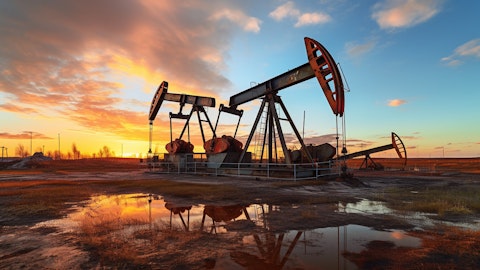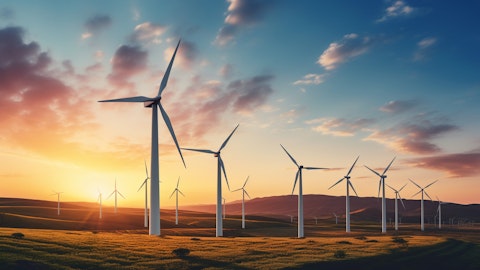Since the company was formed in two, in 2022, we have delivered best in class returns for our sector amounting to over three times the annualized return of the s and p 500 during that same time period. Our performance of the last two years has been driven primarily by low cost execution and a transactions, and as a result, PR remains a compelling value within large capital oil and gas, particularly when recognizing the Permian Resources is now the second largest Permian true plan in the sector. Thank you for tuning in today. And now we’ll turn it back to the operator for Q&A.
Operator: [Operator Instructions] We’ll go first this morning to Neal Dingmann at Truist Securities.
Neal Dingmann: Nice job. My first question, James, maybe on your DNC plan for you or will correct me if I’m wrong, but I believe you’re currently running about 11, 12 rigs, three to four spreads, or about the same as PR and Earthstone was separately. And I’m just wondering, given your notable continued efficiencies that you certainly highlighted today, I’m just wondering, and I believe the goal of relatively flat production maybe could you or will talk about potential to drop rigs or spreads or maybe just how you see the maintenance plan on a go forward.
James Walter : I think you’re right. Like if you think about the plan this year, we were originally saying we drill about 250 wells and the kind of, we thought that would take about 12 rigs. With the efficiencies we’re seeing today, I think it’s very realistic that we could continue to execute on the same plan with less whether that’s 11 rigs or kind of somewhere between 11 and 12, I think is, if we can keep these efficiencies, is very much on the table. If you think back to kind of the Colgate — merger, it’s a very similar playbook. If you think originally that was an eight-rig combined business that we were able to get down to six with the same level of efficiency. We’ve done this before. I do think it’s worth calling out is we’re not solving for kind of some maintenance plan or production per kind of the last part of your question.
It’s much more just an input of what’s the return environment, what’s the macro look like from a supply demand perspective and what does service cost look like so that we can — what the production does is more of an output. If we continue to see strong service or strong oil prices and reduced service costs, I think it’s very, very real that we could decide to kind of keep the 12 rigs or even add rigs from here to go grow production. But what you see in kind of our revised guide is more of that stick to the 250 well, and there’s a real chance we could do that with less equipment.
Neal Dingmann: And then secondly, just quick on the bolt-ons, such as the recent two that you all highlight on specifically, you all seem just to have, continue to have better success adding these creative bolt-ons, versus it just seems like I don’t see as many of your peers being able to do this. I’m just wondering what are the keys behind this and can you kind of continue at this pace of adding a couple, two, three, it seems like almost every quarter.
James Walter : Yes. Thank you. I think that’s a pretty easy answer. I mean, I think first and foremost, it’s something we’re focused on that we prioritize and it’s something we’ve done for a long time and have and continued to be really good at. And I think that’s driven, it should give by a couple of things. I think first and foremost, we have the lowest cost structure in the Delaware Basin, which allows us to earn higher returns on the same assets. And as a result, kind of naturally over time assets like these do just flow to the low cost operator. I would say second, we’re based in Midland, that’s the heart of the Permian, the heart of the deal flow, and we’ve got a great reputation across the market of being good partners that people want to be across the aisle from on the transaction side.
And that goes a long way. And finally for today’s example, I mean, this is really cool and we’re buying in an area where I think we do have a unique edge from activity and therefore the information side of things, we have more rigs running in this area than anybody else, and therefore more proprietary data to pull from better understandings, et cetera. So, I think you take all that together and it does feel like something that is definitely sustainable and edge will continue to have, well we do this every quarter, probably not, but something we expect kind of over the long term to continue to be a big part of the story.
Operator: We go next now to John Freeman at Raymond James.
John Freeman : When I’m looking at slide six and seven and just these huge efficiency gain that you all continue to get out, the legacy Earthstone properties, and I’m just trying to get a sense of what maybe that remaining gap is, if any, between kind of legacy Earthstone and PR on whatever metrics you all want to cite cost per foot or whatever. But when I look at all the different, the drilling days, the completion date, the production downtime, just some sense of how that compares to PR. Just trying to see if there’s still any gap left.
James Walter : I think on the D&C side, the gap is very small, if not kind of non-existent at this point. We are — we have different efficiencies and different assets in different areas, but we kind of view different areas whether, whether it’s legacy Earthstone or legacy PR no longer matters, it’s more, it’s all PR. And I think on the D&C side, that gap is closed. Where I think there’s still some room is on the LOE side. We’ve made tremendous progress in a short amount of time of improving margins through kind of what we’ve done on the contract side, but also just reducing LOE. But a lot of the other LOE stuff, think like SWD disposal agreements or recycling agreements have some time to them and require more work and more time to get fully incorporated. So as I think about kind of where the last kind of gap remains between legacy Earthstone and PR would be more LOE focused, if that makes sense.
John Freeman : That’s perfect. Thanks. And then just the follow up for me. Gas takeaway’s been pretty topical, with what’s going on at Waha. Just any sort of updated thoughts from you all and how you all are thinking about gas takeaway and how to address that longer term?





